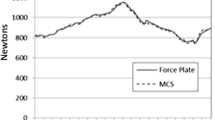Abstract
Algorithms to predict heelstrike and toe-off times during normal running at subject-selected speeds, using only kinematic data, are presented. To assess the accuracy of these algorithms, results are compared with synchronised force platform recordings from ten subjects performing ten trials each. Using a single 180Hz camera, positioned in the sagittal plane, the average RMS error in predicting heelstrike times is 4.5 ms, whereas the average RMS error in predicting toe-off times is 6.9ms. Average true errors (negative for an early prediction) are +2.4 ms for heelstrike and +2.8ms for toe-off, indicating that systematic errors have not occured. The average RMS error in predicting contact time is 7.5ms, and the average true error in predicting contact time is 0.5ms. Estimations of event times using these simple algorithms compare favourably with other techniques requiring specialised equipment. It is concluded that the proposed algorithms provide an easy and reliable method of determining event times during normal running at a subject selected pace using only kinematic data and can be implemented with any kinematic data-collection system.
Similar content being viewed by others
References
Crouse, J., Walls, J. C., andMarble, A. E. (1987): ‘Measurement of the temporal and spatial parameters of gait using a microcomputer based system’,J. Biomed. Eng.,9, pp. 64–68
Gifford, G., andHughes, J. (1983): ‘A gait analysis system in clinical practice’.J. Biomed. Eng.,5, pp. 297–301
Hausdorff, J. M., Ladin, Z., andWei, J. Y. (1995): ‘Footswitch system for measurement of the temporal parameters of gait’,J. Biomech.,28, pp. 347–352
Hreljac, A., andMarshall, R. N. (2000): ‘Algorithms to determine event timing during normal walking using kinematic data’,J. Biomech. 33, pp. 783–786
Liggins, A. B., andBowker, P. (1991): ‘A simple low cost foots-witch’,J. Biomed. Eng.,13, pp. 87–88
Mann, R. A., andHagy, J. (1980): ‘Biomechanics of walking, running, and sprinting’,Am. J. Sports Med.,8, pp. 345–350
Mann, R., andHerman, J. (1985): ‘Kinematic analysis of Olympic sprint performance: Men's 200 meters’,Int. J. Sport Biomech.,1, pp. 151–162
Mann, R. A., Moran, G. T., andDougherty, S. E. (1986): ‘Comparative electromyography of the lower extremity in jogging, running, and sprinting’,Am. J. Sports Med.,14, pp. 501–510
Minns, R. J. (1982): ‘A conductive rubber footswitch design for gait analysis’,J. Biomed. Eng.,4, pp. 328–330
Nilsson, J., Stokes, V. P., andThorstensson, A. (1985): ‘A new method to measure foot contact’,J. Biomech.,18, pp. 625–627
Peham, C., Scheidl, M., andLicka, T. (1999): ‘Limb locomotion-speed distribution analysis as a new method for stance phase detection’,J. Biomech.,32, pp. 1119–1124
Ross, J. D., andAshman, R. B. (1987): ‘A thin foot switch’J. Biomech. 20, pp. 733–734
Shiavi, R., Champion, S., Freeman, F., andGriffin, P. (1981): ‘Variability of electromyographic patterns for level-surface walking through a range of self-selected speeds’,Bull. Prosth. Res. 18, pp. 5–14
Stanhope, S. J., Kepple T. M., McGuire, D. A., andRoman, N. L. (1990): ‘Kinematic-based technique for event time determination during gait’,Med. Biol. Eng. Comput.,28, pp. 355–360
Stergiou, N., Bates, B. T., andJames, S. L. (1999): ‘Asynchrony between subtalar and knee joint function during running’,Med. Sci. Sports Exerc.,31, pp. 1645–1655
Viitasalo, J. T., Luhtanen, P., Mononen, H. V., Norvapalo, K., Paavolainen, L., andSalonen, M. (1997): ‘Photocell contact mat: a new instrument to measure contact and flight times in running’,J. Appl. Biomech.,13, pp. 254–266
Vilensky, J. A., andGehlsen, G. (1984): ‘Temporal gait paramenters in humans and quadrupeds: How do they change with speed?’,J. Hum. Mov. Stud.,10, pp. 175–188
Wells, R. P., andWinter, D. A. (1980): ‘Assessment of signal and noise in the kinematics of normal, pathological, and sporting gaits’, Proc. Special Conf. Canadian Society for Biomechanics, University of Western Ontario, London, pp. 92–93
Winter, D. A. (1987): ‘The biomechanics and motor control of human gait’, (University of Waterloo Press, Waterloo)
Author information
Authors and Affiliations
Corresponding author
Rights and permissions
About this article
Cite this article
Hreljac, A., Stergiou, N. Phase determination during normal running using kinematic data. Med. Biol. Eng. Comput. 38, 503–506 (2000). https://doi.org/10.1007/BF02345744
Received:
Accepted:
Issue Date:
DOI: https://doi.org/10.1007/BF02345744




